| |
Get On the Bus
There is no question about it. Bus travel, long despised and neglected by the snobs and the sophisticates, has come of age. With the round trip fare from Washington D.C. at 35 dollars and the travel time estimated at four and a half hours, it is now a serious alternative way to flying, driving or taking Amtrak.
Washington Deluxe, which picks up passengers near 15th St. and K as well as in Chinatown, is one of the best-run operations with brand new ($400,000) buses and conscientious drivers.
The travel time turns out to be overly optimistic: expect it to take more like 5 hours even with the best of traffic, but the bus drops off passengers right in midtown at 34th Street and 7th Ave, near Penn Station.
The New-York Historical Society
After checking in at my hotel on the Upper West Side, my plan was to walk across Central Park to the Met and spend the afternoon there. On the way up Central Park West a banner hanging from the roof of the New-York Historical Society caught my eye proclaiming The Hudson River School: Nature and the American Vision. This show offers a rare opportunity to view about a hundred landscapes by Thomas Cole, Asher B. Durand, John F. Kensett, Jasper F. Cropsey, and Albert Bierstadt from the society's rich collection.
Cole's The Course of Empire cycle, a wonderfully tragic vision of the rise and fall of civilization was the centerpiece of the show. A generation of American painters learned from Cole how landscape could be used as a metaphor for the national psyche. The sobering and almost philosophical reflection embodied in these five paintings continues to fascinate especially in these challenging times. It seems fitting that they are housed in this museum of the history of the Empire State.
The Met
But the Metropolitan Museum of Art with its fabulous summer blockbusters of Henri Matisse and Coco Channel beckoned. It is always heartening to reach 5th Avenue from whatever destination one is coming from and see the majestic entrance with its long steps and wide banners announcing the new exhibits.
Matisse: The Fabric of Dreams/His Art and His Textiles is not to be missed. In 1905 Matisse, as leader of the Fauves, became famous for bold, simple shapes, strong pure colors, and brilliant design. The exhibit reveals how his revolution in painting was inspired by his long familiarity with and passion for weavings, tablecloths, Turkish robes, Romanian blouses, and Islamic hangings.
Matisse's simplification of form and manipulation of colors put me in mind of another innovator in color and linear pattern who lived six hundred years earlier the great painter of Sienna, Duccio. The Madonna and Child which the museum acquired last year for an astonishing 45 million dollars is a ravishing tour de force by the artist who is as important for art history as Giotto. Calvin Tompkins recounts the acquisition in his New Yorker profile.
Lincoln Center: The Light in the Piazza
The long afternoon was drawing to a close, and it was time to make plans for the evening. I decided to take a bus down 5th Avenue and then walk over to Duffy Square, the center island of 47th Street between Broadway and 7th Avenue for TKTS. The doldrums of summer meant that nearly ever show on Broadway as well as many off, were available that evening for half price. My first choice was The Light in the Piazza, this year's Tony Award Winning Musical.
I would have wanted to see this show just on the promise of the poster by James McMullen. McMullen, who has been creating posters for almost thirty years, may be the best artist ever to devote himself to the New York theatre. Playwright John Guare gets this artist's work exactly right: "they are inventive, they are beautiful, and they are disturbing. He illustrates plays at the highest intentions their authors imagine." The Lincoln Center website has a gallery of his work and an interview.
Piazza is based on a novel by Elizabeth Spencer which became an MGM film in the early sixties starring Olivia de Havilland and Yvette Mimieux as a mother and daughter traveling in 1950's Italy. The musical proves to be a simplified, subtle and finally transcendent rethinking of the film. The evocative sets suggest much-loved locales in Rome and Florence. And how can I fail to mention the opening number with the mother singing about Leonardo and Michelangelo to her daughter in a gallery of the Uffizi?
Piazza is at the Vivian Beaumont Theatre, the theatre at Lincoln Center for whose productions McMullen has done so many memorable posters. At the intermission I was able to admire Henry Moore's Reclining Figure, which sits in a reflecting pool in front of the theatre.
The MoMA
The next morning I made my way to the Museum of Modern Art to view their new building and its current exhibits. MoMA opened late last year but it was so crowed and overwhelming I declined to write about it then. MoMA is still an overwhelming experience and seemed more crowded then the Met though this is clearly impossible..
The big show this summer is Pioneering Modern Painting: Cézanne and Pissarro 1865-1885 the story of two friends and fellow anarchists who spent a lot of years painting together in the region around Pontoise and Auvers. As a number of critics have pointed out, the total of 85 painting hung side by side asks a lot of viewers and wears one down after a while. Moreover, because we know Cézanne is going to come out the real pioneer rather than Pissarro, there seems to lack real dramatic interest in the narrative.
The audio tour does help focus one's attention on a few paintings while the curators make their art history points. The surprise and delight of the show for me and, on the evidence of the crowds standing around it, for the rest of the audience, was Pissarro's magnificent l'Hermitage at Pontoise (1867). This huge landscape offers all the pleasure of the great French tradition of landscape painting which Pissarro learned from Claude and Corot. And for that very reason it shows us how much Cézanne had to jettison in order to make his revolution. Thus one can only agree with him that "If Pissarro had always painted as in 1870, he would have been the strongest among all of us"
The Guggenheim
Finally, Robert Mapplethorpe and the Classical Tradition at the Guggenheim Museum. This must have looked like a great idea on paper. The curators wanted to bring together the bad boy of 80's photography and the bad boys of the 16th century under the guise of the "classical tradition" they both were supposed working within. You didn't know there were bad boys back then? Take a look at this painting by Cornelis Cornelisz. van Haarlem (unfortunately not in the exhibit). There are many more examples of this kind of work both prints and paintings back in the dusty store rooms of major museums. But somebody at the Guggenheim must have lost their nerve and decided to pick the least erotic or offensive (depending on your point of view) work from Mapplethorpe's and the Mannerists' oeuvres.
Artcyclopedia entries for artists mentioned in the text:
Past Articles
2005
The Greatest Painting in Britain
French Drawings and Their Passionate Collectors, by Joseph Phelan
Missing the Picture: Desperate Housewives Do Art History, by Joseph Phelan
The Salvador Dalí Show, by Joseph Phelan
2004
Boston Marathon, by Joseph Phelan
Philadelphia is for Art Lovers, by Joseph Phelan
Featured on the Web: Understanding Islamic Art and its Influence, by Joseph Phelan
Independence Day: Sanford R. Gifford and the Hudson River School, by Joseph Phelan
The "Look" of Mel Gibson's The Passion of the Christ, by Joseph Phelan
The Importance of Being Odd: Nerdrum's Challenge to Modernism, by Paul A. Cantor
2003
Advent Calendar 2003, narrated by Joseph Phelan
If Paintings Could Talk: Paul Johnson's Art: A New History, by Joseph Phelan
Mad Max [Max Beckmann], by Joseph Phelan
Marsden Hartley: The Return of the Native, by Joseph Phelan
Jean-Antoine Houdon: Sculptor of the Enlightenment, by Joseph Phelan
Frederic Remington's Nocturnes, by Joseph Phelan
Magnificenza! Titian and Michelangelo, Manet and Velazquez, by Joseph Phelan
Masterful Leonardo and Graphic Dürer, by Joseph Phelan
Favorite Online Art Museum Features, by Joseph Phelan
Studies for Masterpieces, by John Malyon
2002
Portrait of the Artist as a Serial Killer, by Joseph Phelan
Renoir's Travelling, Bonnard's "At Home", by Joseph Phelan
The Philosopher as Hero: Raphael's The School of Athens, by Joseph Phelan
The Greatest Works of Art of Western Civilization
Celebrating Heroes; Celebrating Benjamin West, by Joseph Phelan
Chasing the Red Deer into the American Sublime (Education and the Art Museum, Part II), by Joseph Phelan
Planning Your Summer Vacation, by Joseph Phelan
Education and the Art Museum, Part I, by Joseph Phelan
Unsung Griots of American Painting, by Joseph Phelan
The British Museum COMPASS Project, interview by Joseph Phelan
Robert Hughes, Time Magazine Art Critic: Biography and Writings
2001
Software review: Le Louvre: The Virtual Visit on DVD-ROM, by Joseph Phelan
Tragedy and Triumph at Arles: Van Gogh and Gauguin, by Joseph Phelan
Her Last Bow: Sister Wendy in America, by Joseph Phelan
Love, Death and Resurrection: The Paintings of Stanley Spencer, by Joseph Phelan
Who is Rodin's Thinker?, by Joseph Phelan
Celebrations North and South, by Joseph Phelan
Rubens and his Age, by Joseph Phelan
Great Reproductions of Great Paintings
The Passion of Christ, by Joseph Phelan
Edouard Manet: Public Spaces, Private Dreams, by Joseph Phelan
Henry Moore and the British Museum: The Great Conversation, by Joseph Phelan
2000
Notorious Portraits, Part II, by John Malyon
Notorious Portraits, Part I, by John Malyon
The Other Michelangelo, by Joseph Phelan
The Art of Drawing, by Joseph Phelan
Poussin and the Heroic Landscape, by Joseph Phelan
Great Art Museums Online, by Joseph Phelan
Venetian Painting and the Rise of Landscape, by Joseph Phelan
Forbidden Visions: Mythology in Art, by Joseph Phelan
Themes in Art: The Passion of Christ, by Joseph Phelan
Web site review: Christus Rex
Web site review: National Gallery of Art, Washington, D.C., by Joseph Phelan
Online exhibit review: Inuit Art: The World Around Me, by John Malyon
Poll: Who is Producing the Most Interesting Art Today? (Results)
Poll: Who is Producing the Most Interesting Art Today? (Part II)
1999
Poll: Who is Producing the Most Interesting Art Today? (Part I)
Spotlight on The Louvre Museum
Spotlight on Impressionism
Spotlight on Optical Art
Spotlight on Animals in Art
Spotlight on Surrealism
Spotlight on Sculpture
Spotlight on Women in the Arts
Spotlight on The Golden Age of Illustration
Spotlight on Vincent van Gogh
Spotlight on Great Art
|
|
Thomas Cole:
The Course of Empire
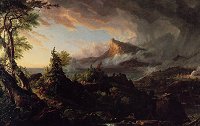
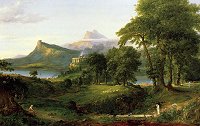
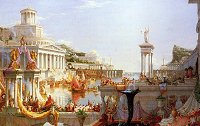
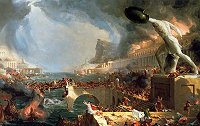
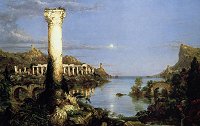
|
|